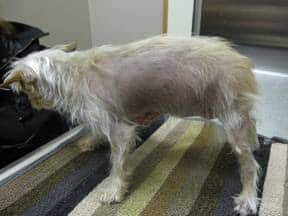
Signs associated with Cushing’s disease may include increased thirst and urination, a voracious appetite, an enlarged and sagging belly, hair loss, lethargy/weakness, panting, and sometimes, recurrent infections.
Cushing’s disease, also called Cushing’s syndrome or hyperadrenocorticism, results from an overproduction of the hormone cortisol. Cortisol is produced by the adrenal glands, located next to the kidneys, and adrenal glands are stimulated to produce cortisol by the pituitary gland located at the base of the brain. There are two types of Cushing’s disease. In adrenal-dependent Cushing’s disease, an adrenal gland overproduces cortisol because of an adrenal tumor. In pituitary-dependent Cushing’s disease, the adrenal glands overproduce cortisol because they are overstimulated by a pituitary tumor.
Diagnosis
Cushing’s disease can be difficult to diagnose, especially in early cases. Tests that may be needed to diagnose Cushing’s disease include:
- Complete blood count (CBC), chemistry panel and urinalysis: These blood and urine tests evaluate the general health of your pet and can help your veterinarian determine if other health problems should be suspected.
- Adrenocorticotrophic hormone (ACTH) stimulation test: This test involves a blood sample, an injection of a hormone (ACTH), an hour of waiting, and then another blood sample. This test is used to diagnose Cushing’s disease in a pet.
- Low-dose dexamethasone suppression test: This test takes longer to perform than the ACTH stimulation test and takes place over 8 hours. It involves a blood sample, an injection of a steroid, a few hours of waiting, another blood sample at 3 hours, more waiting, and then another blood sample at 8 hours. This test is used to diagnose Cushing’s disease. Sometimes this test can also determine where the problem is in the pet’s body (i.e., pituitary or adrenal).
- High-dose dexamethasone suppression test (HDDST): This test is similar to the LDDST except that it uses a higher dose of dexamethasone. It is used to determine where the problem is in the pet’s body (i.e. pituitary or adrenal).
- Endogenous adrenocorticotrophic (ACTH) assay, or ACTH level: This test involves a single blood sample. It is used to determine where the problem is in the pet’s body (i.e. pituitary or adrenal).
- Radiographs, abdominal ultrasound, or CT scan: Radiographs can help us see changes in other organs that could indicate Cushing’s. An abdominal ultrasound can help us see the adrenal glands. Sometimes, a CT scan can be performed to help us evaluate the pituitary gland at the base of the brain.
Treatment
Treatment consists of medication to control the cortisol overproduction by the adrenal gland or surgery to remove the abnormal adrenal gland. Choosing the best treatment for a pet with Cushing’s disease depends upon where the problem is in your pet’s body (i.e. pituitary or adrenal gland).


